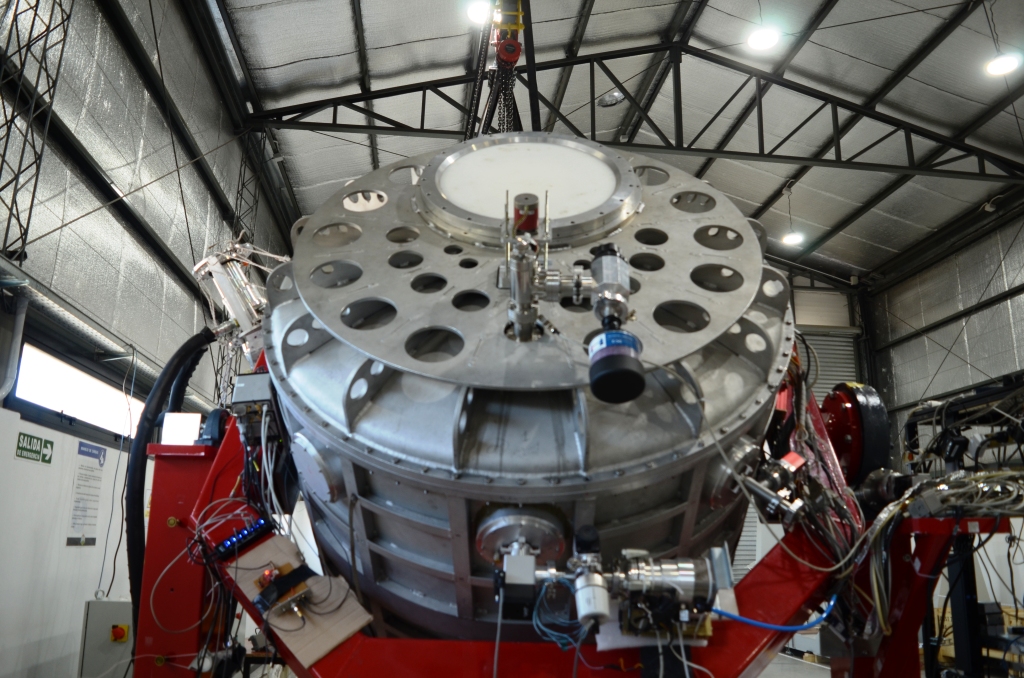At 5,000 meters above sea level, a world-class instrument employs state-of-the-art science to uncover verifiable clues to the time when everything we know began to exist. This is QUBIC, an innovative astronomical instrument that combines the sensitivity of a bolometric detector, cooled to 273 degrees Celsius below zero (-273°C) with the precision of interferometric techniques and the possibilities of spectral imaging: simultaneous measurement of the color of each image pixel, which allows for reduced mode B non-primordial.
Scientists from the Astroparticle Detection Technology Institute (ITEDA) – which forms the National Atomic Energy Commission, CONICET and UNSAM – are participating in the project, along with researchers from France, Italy, the UK and Ireland.
The instrument was originally developed in France and Italy, with collaboration from Ireland, the United Kingdom and the United States, and was assembled, operated and tested in a National Atomic Energy Commission laboratory.
QUBIC competes with several other observational cosmology projects investigating primordial B-modes: BICEP/KECK, CLASS, SPIDER from the United States, Ali-CPT from China, and the Japanese satellite project (with a major European contribution) LiteBIRD (planned for 2033). ). However, none of these telescopes can compare to QUBIC in terms of the possibilities offered by interferometry.
Although the recent discovery of the B mode must be independently confirmed by various groups, the QUBIC collaboration is positioned on a high-impact topic in Cosmology, and particularly in Argentina.
Tasks performed in Argentina
The QUBIC project is the result of a collaboration between 130 researchers and engineers in France, Italy, Argentina, the UK and Ireland. The instrument was developed in France at APC (Paris) between 2008 and 2018 and tested in the same laboratory between 2019 and 2020.
In July 2021 he arrived in Argentina. It was transferred to the Integration Laboratory, at CNEA Northwest Regional (built specifically for this purpose) in Salta, where it was assembled, put into operation and tested for a year.
In addition, the following tasks were carried out in our country: design and construction of frames, frame movement systems, cryogenic laboratory at Constituyentes Atomic Center; from membrane discharge systems to incident radiation absorbers from cryogenic quantum sensors and domes. On the other hand, the infrastructure housing the telescope at Alto Chorrillos was built, with the installation of generators and fuel tanks as well as the design and construction of the electrical system. These tasks should be complemented by others such as construction of access roads and installation of shelters, as well as bringing electricity and communications to the site.
The instrument is now operational and ready to begin acquiring data for calibration.
Doing cutting-edge science allows cutting-edge technologies to be developed
QUBIC tries to cover the first moments of Cosmos. The theory of cosmological inflation was proposed in the 1980s to explain flat geometry and the extreme homogeneity of space-time. Inflation provided the physical mechanism for producing primordial density fluctuations in the universe, which gave rise to large-scale structures (galaxy clusters, galaxies, stars). This is the period during which the Universe underwent a very rapid expansion, which occurred about 10-35 seconds after the Big Bang.
Although all observations to date agree with the theory of inflation, we still have no direct evidence that it actually occurs. If inflation does occur, calculations show that it should leave tiny traces in the form of primordial gravitational waves, which will leave their mark on the cosmic microwave background in the form of a certain type of polarizing radiation, called B-modes. , which cannot be generated by any other primordial mechanism. If the primordial B mode is detected, it will be direct evidence of phase inflation, an important result in cosmology with profound consequences for particle physics.
The study of B-mode patterns will enable fundamental physics studies at energies that are impossible to achieve in particle accelerators for centuries to come. The search for mode B presents a major challenge for astrophysicists. The expected signal is very weak and its detection requires ultrasensitive detectors and very precise telescopes. It is not easy to analyze signals originating from the microwave background, as they are also affected by the presence of a non-primordial B mode, which is generated by dust in our own galaxy and must be eliminated.
Despite the impressive advances made in our understanding of the Universe in recent decades, there are still some puzzles that remain unsolved, such as those related to dark matter, dark energy, or what happened in the early days of the universe.

“Entrepreneur. Internet fanatic. Certified zombie scholar. Friendly troublemaker. Bacon expert.”







